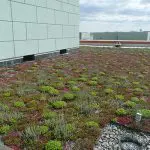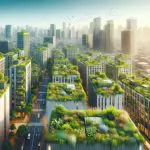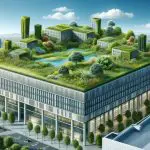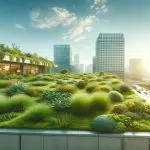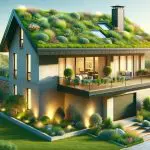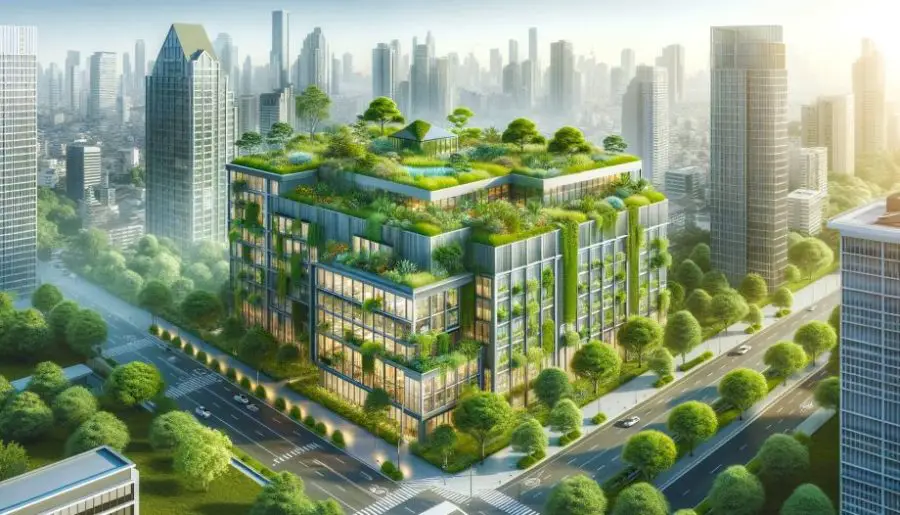
Explore the world of green roof sustainability – an innovative way to beautify and improve urban environments. Dive into our insightful guide now!
Green Roof Sustainability Key Takeaways:
- Green roof sustainability involves creating rooftop green spaces They offer:
- Environmental benefits like air purification
- Reduction of urban heat island effect
- Effective stormwater management
- Enhanced biodiversity
- Improved energy efficiency.
- It’s a key strategy in making urban areas more livable and sustainable.
Welcome to a greener future! In this article, we’re diving into the exciting world of green roof sustainability.
These eco-friendly oases are not just a treat for the eyes but a boon for our urban landscapes, offering a blend of beauty, environmental care, and urban harmony.
Join us as we unravel the layers of this sustainable marvel.
Introduction to Green Roofs
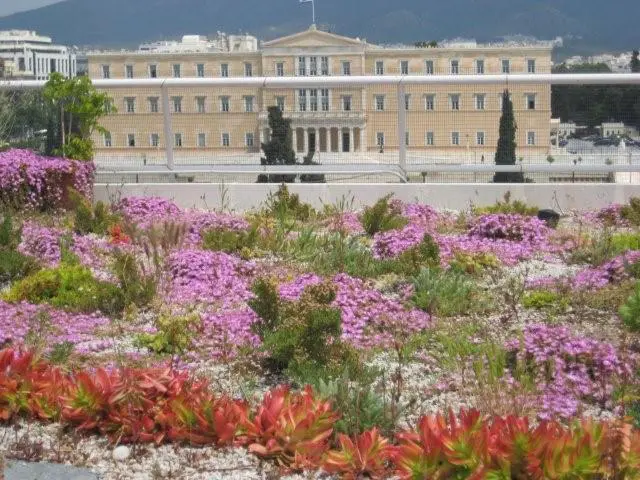
Green roofs are transforming our urban landscapes. These innovative structures, covered with plants and vegetation, offer a sustainable solution for modern city living.
They’re not just about adding greenery; they play a crucial role in improving the environment and quality of life in urban areas.
Their growing popularity reflects a commitment to sustainable development, making our cities greener and more efficient.
What is a Green Roof?
A green roof is a roof of a building that is partially or completely covered with vegetation and a growing medium, planted over a waterproofing membrane.
It may also include additional layers such as a root barrier and drainage and irrigation systems. Read more: What is a Green Roof? 10 Astonishing Innovative Facts
Types of Green Roofs
- Extensive Green Roofs: These are lightweight, low-maintenance, and designed primarily for environmental benefits. They typically have a shallow growing medium.
- Intensive Green Roofs: These are thicker and can support a wider variety of plants, but require more maintenance and structural support.
- Semi-Intensive Green Roofs: A blend of extensive and intensive, these roofs offer a balance of ecological function and usability.
Importance in Urban Areas
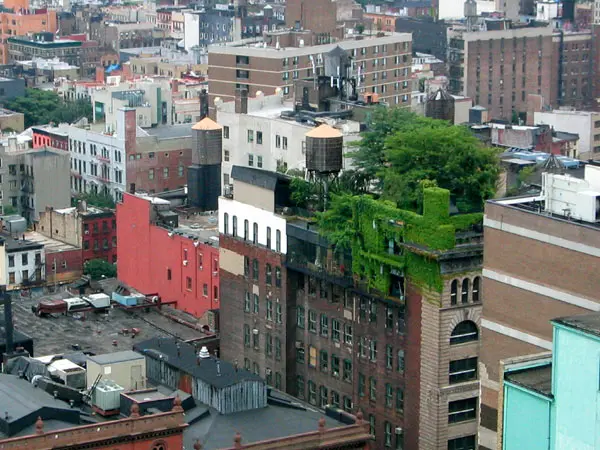
In urban environments, green roofs are vital in addressing several challenges:
- Combatting Urban Heat Island Effect: By providing natural insulation, they help lower temperatures in densely populated areas.
- Stormwater Management: They absorb and manage rainwater, easing the burden on urban drainage systems.
- Enhancing Air Quality: The plants on green roofs help filter pollutants from the air, improving the overall air quality.
Green Roof Design
Designing a green roof involves considering various factors:
- Weight and Structural Support: Assessing the building’s ability to support the additional weight is crucial.
- Plant Selection: Choosing plants that are suitable for the local climate and roof conditions.
- Waterproofing and Drainage: Ensuring that the roof is adequately waterproofed and has an effective drainage system.
Popularity and Trends
Green roofs have gained significant traction in recent years for their environmental benefits and ability to enhance urban living spaces.
They are increasingly viewed as an integral part of sustainable urban development, reflecting a growing awareness and commitment to eco-friendly practices.
Table: Introduction to Green Roofs
| Aspect | Description |
|---|---|
| Definition | A green roof is a roof covered with vegetation and soil over a waterproof membrane. |
| Types | Extensive (lightweight, low maintenance), Intensive (supports a wider variety of plants, requires more maintenance), Semi-Intensive (combination of both). |
| Importance | Combatting urban heat island effect, enhancing air quality, and aiding in stormwater management. |
| Design Considerations | Weight capacity, plant selection, waterproofing, and drainage. |
| Popularity Trends | Rising use in urban areas for sustainability and aesthetic appeal. |
Benefits of Green Roofs
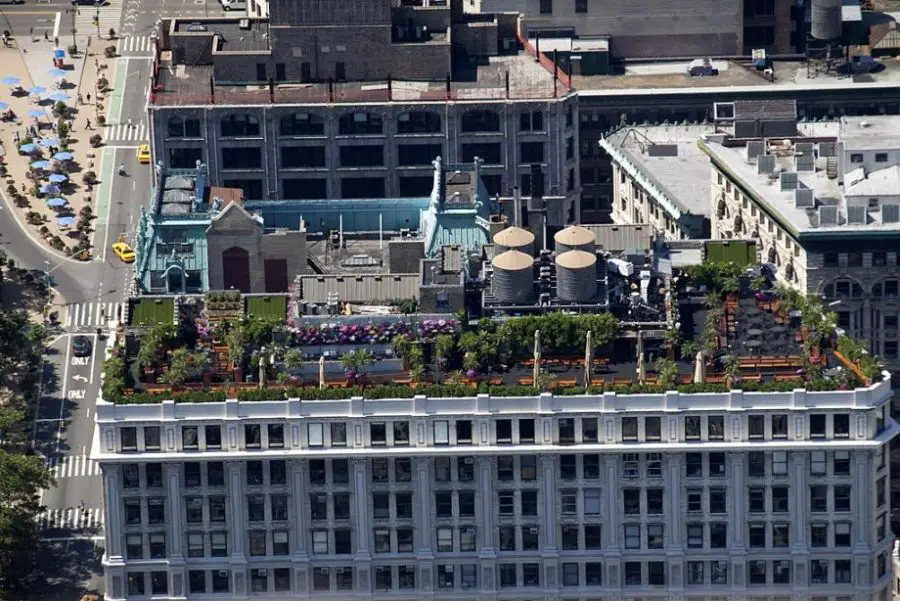
Green roofs offer a multitude of benefits, making them an attractive option for urban development. Let’s delve into these advantages:
Air Purification and CO2 Reduction
- Natural Air Filters: The plants on green roofs act as natural air purifiers. They absorb pollutants and particulate matter, improving the overall air quality in urban areas.
- CO2 to Oxygen Conversion: These roofs play a critical role in converting carbon dioxide into oxygen, helping to reduce the levels of this greenhouse gas in the atmosphere.
Mitigating the Urban Heat Island Effect
- Cooling Urban Spaces: Green roofs absorb sunlight, which helps in reducing the urban heat island effect. This phenomenon is where urban areas experience higher temperatures than their rural counterparts due to concrete and asphalt absorbing heat.
- Temperature Regulation: By reflecting heat and providing natural insulation, green roofs contribute to cooling the surrounding environment, potentially lowering city-wide temperatures significantly.
Stormwater Management
Stormwater, also written storm water, is water that originates from precipitation (storm), including heavy rain and meltwater from hail and snow. Stormwater can soak into the soil (infiltrate) and become groundwater, be stored on depressed land surface in ponds and puddles, evaporate back into the atmosphere, or contribute to surface runoff. Most runoff is conveyed directly as surface water to nearby streams, rivers or other large water bodies (wetlands, lakes and oceans) without treatment. https://en.wikipedia.org/wiki/Stormwater
- Natural Rainwater Absorption: Green roofs absorb and retain rainwater, which helps reduce the burden on city drainage systems.
- Improved Water Quality: The vegetation on green roofs naturally filters rainwater, leading to cleaner runoff entering urban water systems.
Biodiversity and Habitat Creation
- Supporting Urban Wildlife: By providing green space, these roofs create habitats for various species, including birds, insects, and native plants, enriching urban biodiversity.
- Miniature Ecosystems: They act as small ecosystems within urban environments, offering a much-needed space for wildlife to thrive.
Energy Efficiency
- Insulation Benefits: The layer of soil and vegetation on green roofs provides natural insulation, reducing the need for artificial heating and cooling in buildings. This translates into significant energy savings.
- Reduced Energy Costs: Buildings with green roofs have been shown to have lower energy costs due to the reduced demand for air conditioning in summer and heating in winter.
Noise Reduction
- Sound Insulation: Green roofs are effective in absorbing ambient noise, making urban areas quieter, especially in densely populated regions.
- Peaceful Urban Environments: They contribute to creating more serene and peaceful urban spaces, enhancing the quality of life for city dwellers.
These benefits showcase the multifaceted role of green roofs in enhancing urban environments. They not only improve the ecological balance but also offer practical solutions to common urban challenges.
Table: Benefits of Green Roofs
| Benefit Category | Description |
|---|---|
| Air Quality | Filters pollutants and converts CO2 into oxygen. |
| Urban Heat | Reduces urban heat island effect by absorbing sunlight. |
| Stormwater Management | Absorbs rainwater, reducing runoff and improving water quality. |
| Biodiversity | Provides habitats for wildlife, enhancing urban biodiversity. |
| Energy Efficiency | Insulates buildings, reducing energy costs. |
| Noise Reduction | Acts as a sound barrier, creating quieter urban spaces. |
Practical Aspects of Green Roofs
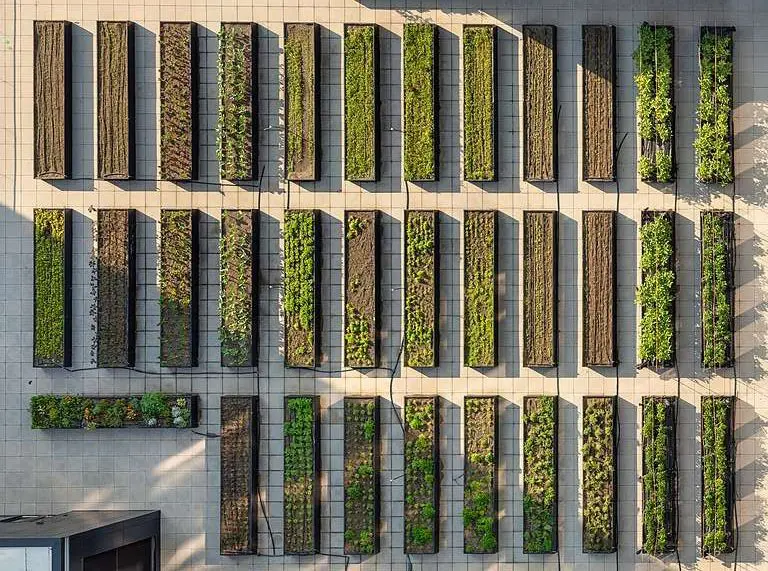
Green roofs aren’t just beneficial for the environment; they also present practical advantages in terms of installation, maintenance, sustainability, and economics. Let’s explore these aspects:
Ease of Installation and Maintenance
- Simplified Installation Process: Modern green roof systems, especially those using pre-cultivated vegetation blankets, simplify the installation process. These blankets can be rolled out like a carpet on existing roof structures, making the setup quicker and more efficient.
- Long-Term Cost Benefits: While the initial installation cost might be higher than traditional roofs, green roofs offer long-term financial benefits. They require minimal maintenance, mainly periodic weeding, and watering, which can often be managed through integrated irrigation systems.
Sustainability and Life Span
- Protection from Environmental Elements: The layer of vegetation and soil on green roofs protects the underlying roofing material from extreme temperatures, solar radiation, and mechanical damage. This protection can extend the life span of the roof, often doubling or tripling its longevity compared to conventional roofs.
- Environmental Sustainability: Green roofs contribute to the sustainability of a building by enhancing energy efficiency and reducing the need for artificial climate control. This aligns with the broader goals of sustainable development and urban resilience against climate change.
Economic Implications
- Cost-Effectiveness: Despite the initial investment, green roofs are economically beneficial in the long run. They contribute to energy savings by providing natural insulation and reducing the costs of heating and cooling buildings.
- Increased Property Values: Buildings with green roofs often have higher market values. They are seen as more attractive and eco-friendly, appealing to buyers and tenants who value sustainability and quality of living.
- Potential for Government Incentives: In many urban areas, installing green roofs can qualify property owners for tax credits, rebates, and other government incentives, further offsetting the initial costs.
In summary, the practical aspects of green roofs – from their installation and maintenance to their economic and sustainability benefits – make them a viable and advantageous option for modern buildings. They represent a smart investment in both the property’s value and the broader environmental well-being of urban spaces.
Table: Practical Aspects of Green Roofs
| Aspect | Description |
|---|---|
| Installation | Often involves pre-cultivated vegetation blankets for ease of setup. |
| Maintenance | Requires minimal, periodic upkeep like weeding and watering. |
| Sustainability | Contributes to long-term building sustainability. |
| Economic Benefits | Long-term cost savings, potential for increased property value. |
Social and Psychological Impacts
Green roofs not only transform urban landscapes physically but also have profound social and psychological effects on city dwellers. Let’s delve into these impacts:
Enhancing Quality of Life in Urban Areas
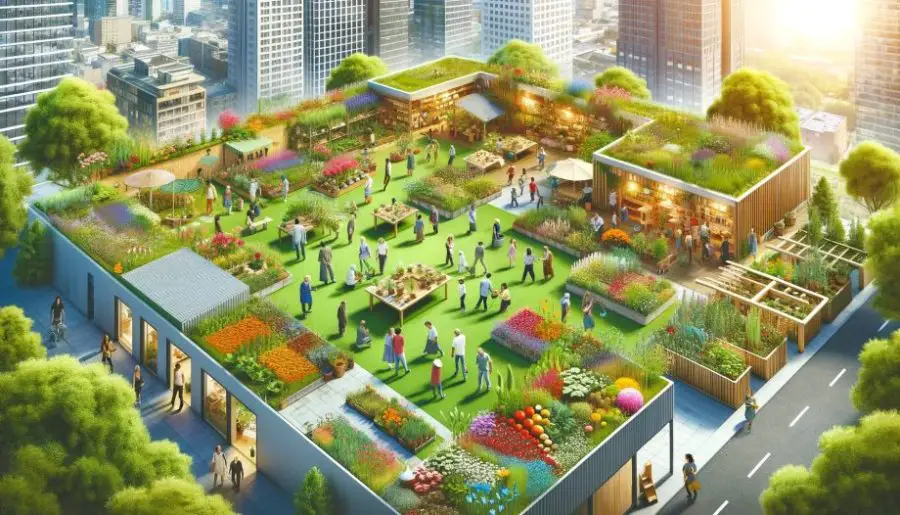
- Creating Relaxation Spaces: Green roofs offer a tranquil retreat in the heart of bustling cities. They provide residents with spaces to relax, unwind, and connect with nature, which is often scarce in urban settings.
- Fostering Community Engagement: These green spaces can become communal areas where people interact and engage with their neighbors. They encourage community activities, such as gardening or social gatherings, enhancing the social fabric of urban neighborhoods.
- Aesthetic Value: The visual appeal of green roofs contributes to a more pleasant urban environment, uplifting the spirits of those who live and work around them.
Health Benefits
- Mental Health Improvement: Proximity to green spaces, including green roofs, has been shown to have a positive impact on mental health. They offer an escape from the urban grind, helping to reduce stress and anxiety.
- Stress Reduction and Relaxation: The natural setting of green roofs provides a calming environment, which can significantly reduce stress levels and promote relaxation.
- Faster Recovery for Patients: Studies have found that patients with access to green spaces, including views of green roofs, tend to recover faster and require less medication. This phenomenon, known as the ‘healing environment’, demonstrates the significant health benefits of integrating nature into urban design.
The social and psychological impacts of green roofs underscore their importance in enhancing the quality of life in urban areas. They go beyond the physical benefits, touching on the mental well-being and community spirit of urban dwellers.
Challenges and Considerations
While green roofs offer numerous benefits, there are several challenges and considerations to take into account before implementation:
Initial Costs
- Higher Upfront Investment: The initial cost of installing a green roof is generally higher than that of a traditional roof. This includes expenses related to additional layers, such as waterproof membranes, drainage systems, and the vegetation layer itself.
- Professional Design and Installation: Green roofs often require specialized design and installation services, which can add to the overall cost.
Structural Requirements
- Weight Considerations: Green roofs are heavier than conventional roofs due to the soil, vegetation, and retained water. Buildings must be evaluated for their ability to support this extra weight, which might necessitate structural reinforcement.
- Waterproofing and Drainage: Ensuring a robust waterproofing system is crucial to prevent leaks. Adequate drainage must also be incorporated to manage water retention and runoff.
Maintenance Requirements
- Ongoing Maintenance: Unlike traditional roofs, green roofs require regular maintenance, including watering, weeding, and managing plant health. This can be a significant consideration for building owners and managers.
- Expertise for Upkeep: Maintaining a green roof often requires knowledge of horticulture and irrigation systems, which might necessitate hiring skilled personnel or training existing staff.
Climatic and Environmental Limitations
- Climate Suitability: The success of a green roof largely depends on the local climate. In areas with extreme weather conditions, maintaining a green roof can be more challenging.
- Plant Selection: Choosing the right plants is crucial for a green roof’s success. Not all plants are suitable for the unique conditions found on rooftops, such as high wind exposure and varying moisture levels.
Regulatory and Policy Challenges
- Building Codes and Regulations: In some regions, there may be building codes and regulations that complicate the installation of green roofs. Navigating these can require additional time and resources.
- Lack of Incentives: In areas without governmental incentives or subsidies for green roof installation, the financial burden falls entirely on the building owner, which can be a deterrent.
Table: Challenges and Considerations
| Challenge | Description |
|---|---|
| Initial Costs | Higher upfront investment compared to traditional roofs. |
| Structural Requirements | Need for evaluation and possible reinforcement of building structure. |
| Maintenance | Requirement for ongoing care and expertise. |
| Climatic Limitations | Suitability varies with local climate and environmental conditions. |
| Regulatory Challenges | Navigating building codes and lack of incentives in some areas. |
These tables provide a concise and organized overview of the main topics discussed in the blog post, allowing readers to quickly grasp the key points.
These challenges highlight the need for careful planning and consideration when implementing green roofs. It’s important to weigh these factors against the potential benefits to determine the feasibility and long-term viability of a green roof project.
Case Studies and Examples
1. Ford’s Dearborn Truck Plant – Michigan, USA
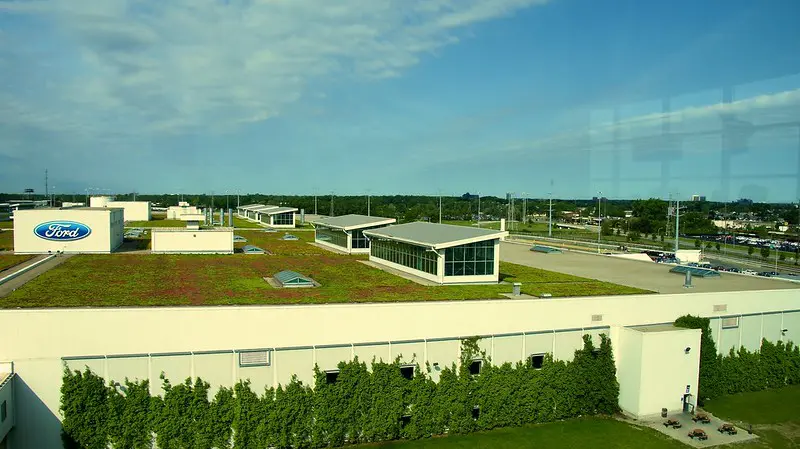
- Overview: This facility boasts one of the largest living roofs in the world. Spanning over 10.4 acres, this extensive green roof is part of Ford’s Rouge Center revitalization project.
- Impact: The roof contributes significantly to stormwater management, reducing runoff and improving water quality. It also aids in energy efficiency and has become a habitat for wildlife, showcasing the environmental benefits of green roofs in an industrial setting. Read more
2. California Academy of Sciences – San Francisco, USA
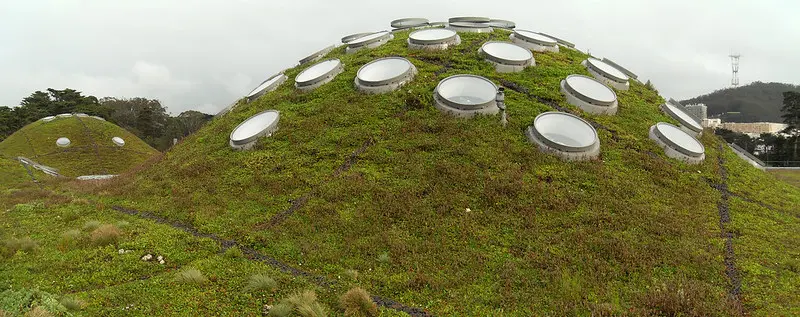
- Overview: The academy’s building features a 2.5-acre living roof with native plant species.
- Impact: This green roof is known for its biodiversity, housing numerous plant and animal species. It also reduces the building’s energy needs and helps regulate the indoor temperature, enhancing the building’s overall sustainability. Read more
3. ACROS Fukuoka Prefectural International Hall – Japan
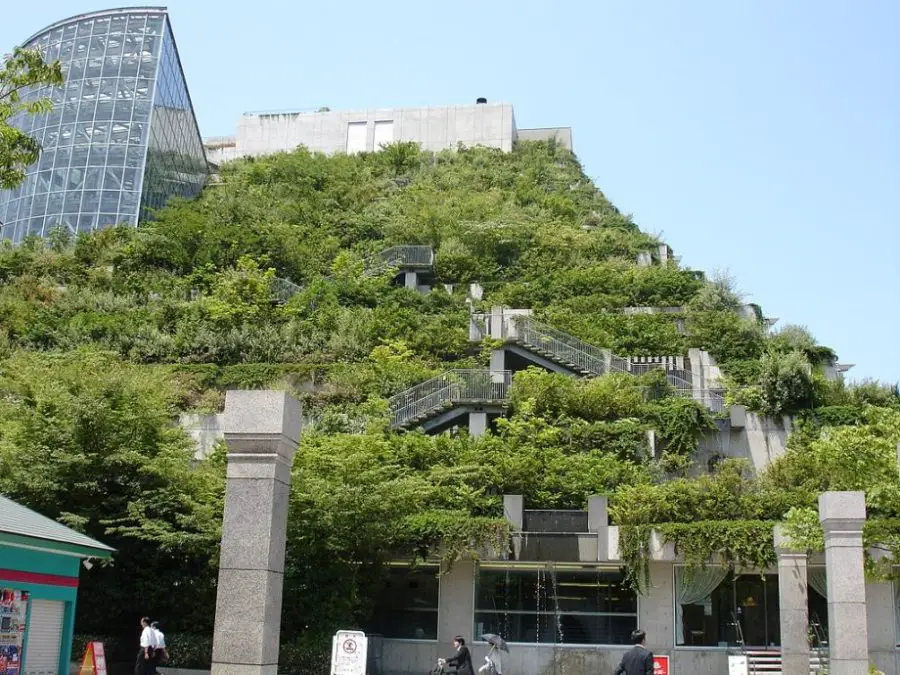
- Overview: A stunning example of urban architecture blending with nature, this building in Fukuoka has a series of large terraced gardens that serve as green roofs.
- Impact: The green terraces help mitigate the urban heat island effect and provide a serene green space in the middle of the city. They also contribute to local biodiversity and have become a popular attraction for both locals and tourists. Read more
4. Chicago City Hall – Chicago, USA
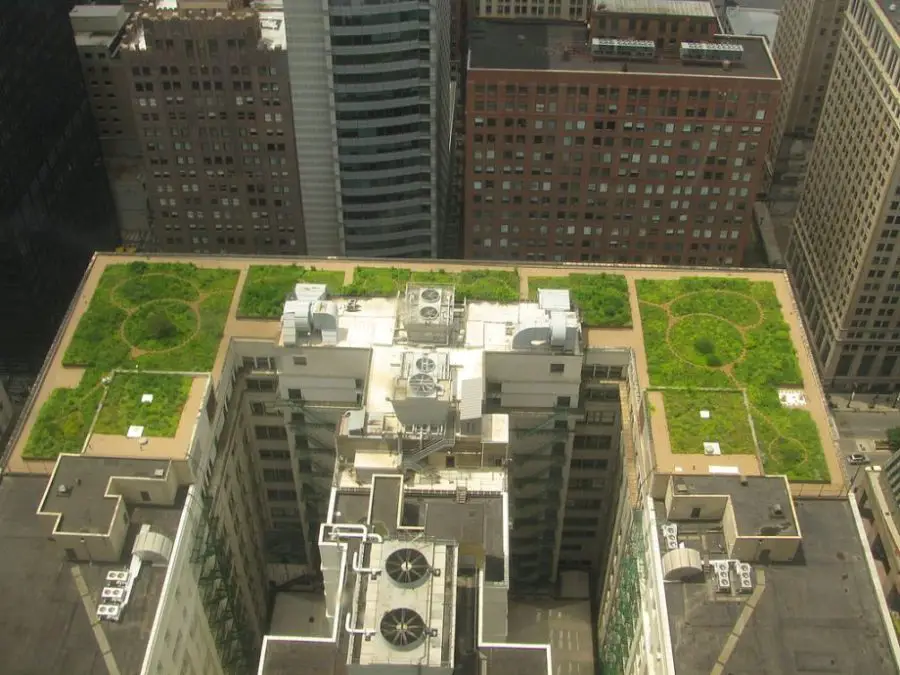
- Overview: The City Hall of Chicago features an 11th-floor rooftop garden, serving as a demonstration project for the cooling effects of green roofs.
- Impact: This project has shown a significant reduction in surface temperature compared to neighboring buildings. It also serves as a habitat for local wildlife and helps manage stormwater runoff.
5. Barclays Bank HQ – London, UK
- Overview: The Barclays Bank headquarters in London features a green roof system that is home to various plant species and local wildlife, including rare bird species.
- Impact: The green roof contributes to local biodiversity, improves air quality, and reduces the building’s carbon footprint. It also serves as a research site for studying the benefits of urban green spaces. Read more
These examples demonstrate the diverse applications and benefits of green roofs across different settings – from industrial complexes to urban centers.
They showcase how green roofs can be effectively integrated into various types of buildings, contributing to urban sustainability and environmental conservation.
Green Roof Sustainability FAQs
Green roofs are a growing trend in urban sustainability, sparking curiosity and questions about their benefits, feasibility, and role in environmental conservation.
To help demystify this eco-friendly technology, here are some of the most commonly asked questions about green roofs, providing clear and concise answers to enhance your understanding of their significance in today’s urban landscapes.
Q. What is a Green Roof?
A: A green roof is a roof of a building that is partially or completely covered with vegetation and soil, or a growing medium, planted over a waterproofing membrane.
It may also include additional layers such as a root barrier and drainage and irrigation systems.
Q. How Do Green Roofs Help the Environment?
A: Green roofs provide environmental benefits by improving air quality, reducing the urban heat island effect, managing stormwater runoff, and supporting biodiversity.
They absorb pollutants and CO2, help lower urban temperatures, filter rainwater, and provide habitats for wildlife.
Q. What are the Different Types of Green Roofs?
A: There are mainly two types: Extensive green roofs, which are lightweight and low maintenance, suitable for larger areas, and intensive green roofs, which are thicker, can support a wider variety of plants, and require more maintenance.
Q. Are Green Roofs Actually Sustainable?
A: Yes, green roofs are considered sustainable. They contribute to environmental sustainability by improving air quality, reducing urban heat, managing stormwater, and increasing biodiversity.
They also offer sustainability in building design by enhancing energy efficiency and prolonging the lifespan of roofing materials.
Q. What is the Role of Green Roofs in Sustainable Development?
A: Green roofs play a significant role in sustainable development. They help in creating more sustainable urban spaces by reducing the need for artificial cooling, managing stormwater naturally, and improving urban air quality.
They also contribute to biodiversity and provide green spaces in densely populated urban areas, aligning with the goals of sustainable urban development.
Q. What are 5 Benefits of a Green Roof?
A:
- Improved Air Quality: They filter pollutants and reduce CO2 levels.
- Reduced Urban Heat Island Effect: They help lower urban temperatures.
- Effective Stormwater Management: Green roofs absorb rainwater, reducing runoff and improving water quality.
- Enhanced Biodiversity: They provide habitats for various urban wildlife species.
- Energy Efficiency: Green roofs offer natural insulation, reducing energy costs for heating and cooling.
Q. Are Green Roofs Expensive?
A: The initial installation cost of green roofs can be higher than conventional roofs.
However, they offer long-term cost benefits through energy savings, reduced stormwater management costs, and an extended lifespan for the roofing material.
Q. Can Green Roofs be Installed on Any Building?
A: Green roofs can be installed on various buildings, but it’s essential to consider the structural capacity of the building.
A professional assessment is necessary to ensure the building can support the additional weight of a green roof.
Q. How are Green Roofs Maintained?
A: Maintenance depends on the type of green roof. Extensive green roofs require minimal maintenance, primarily weeding and occasional watering, while intensive green roofs need regular watering, weeding, and management of the plantings.
Q. Do Green Roofs Contribute to Energy Efficiency?
A: Yes, green roofs contribute to energy efficiency by providing insulation.
They reduce the need for heating and cooling in buildings, leading to lower energy consumption and costs.
Q. Can Green Roofs Extend the Lifespan of a Roof?
A: Yes, green roofs can extend the lifespan of a roof by protecting the roofing material from UV radiation, extreme temperatures, and physical damage.
This can double or even triple the roof’s lifespan compared to conventional roofs.
Q. What are the Challenges of Installing a Green Roof?
A: Challenges include the initial higher cost, the need for structural assessment and potential reinforcement of the building, and the requirement for ongoing maintenance and specialized knowledge for upkeep.
These FAQs cover the key aspects and common queries regarding green roofs, offering concise and informative responses to the most frequently asked questions by those interested in this sustainable building practice.
Green Roof Sustainability Conclusion
In this exploration of green roofs, we’ve uncovered their multifaceted benefits and practical aspects, making them not just a visually appealing addition to urban landscapes but a vital component of sustainable urban development.
Environmental Benefits
Green roofs stand out for their ability to improve air quality, mitigate the urban heat island effect, manage stormwater effectively, support urban biodiversity, and enhance energy efficiency.
The practical considerations, although challenging, highlight the importance of thoughtful planning and implementation.
Health Benefits
Moreover, the social and psychological impacts of green roofs, including enhanced quality of life and health benefits, are significant in creating more livable and resilient urban spaces.
The case studies provided real-world examples of green roofs’ positive impacts, demonstrating their versatility and adaptability across various settings and building types.
The Future of Green Roofs
As we look towards the future of urban planning and individual building projects, the inclusion of green roofs should be a key consideration.
They offer a tangible solution to many environmental challenges faced by modern cities and can play a pivotal role in driving sustainable urban development.
By integrating green roofs into our buildings, we’re not just investing in the infrastructure; we’re investing in a greener, healthier future for our urban environments.
This exploration encourages us to think green – not just at ground level but all the way up to our rooftops.
The potential of green roofs is vast, and their implementation can significantly contribute to the sustainability and livability of our urban areas.
Additional Resources on Green Roofs
To deepen your understanding of green roofs and their impact on sustainable urban development, the following resources are highly recommended.
They offer comprehensive insights into the subject, covering various aspects from environmental benefits to practical implementation strategies.
- Green Roofs for Healthy Cities: As mentioned earlier, an excellent starting point for comprehensive insights into green roofs.
- American Society of Landscape Architects – Green Roofs: This resource offers detailed information on the design and benefits of green roofs, with a focus on landscape architecture.
- The Benefits and Challenges of Green Roofs on Public and Commercial Buildings by GSA: A thorough report by the U.S. General Services Administration detailing the benefits, challenges, and best practices for green roofs on public and commercial buildings.
- Design Guidelines and Maintenance Manual for Green Roofs In the Semi-Arid and Arid West by EPA: This guide by the Environmental Protection Agency is tailored to green roof implementation in specific climatic conditions.
These resources provide a well-rounded understanding of green roofs, covering various aspects from environmental impact to practical implementation tips.
They are valuable for anyone looking to delve deeper into the subject, whether for educational, professional, or personal interests.

